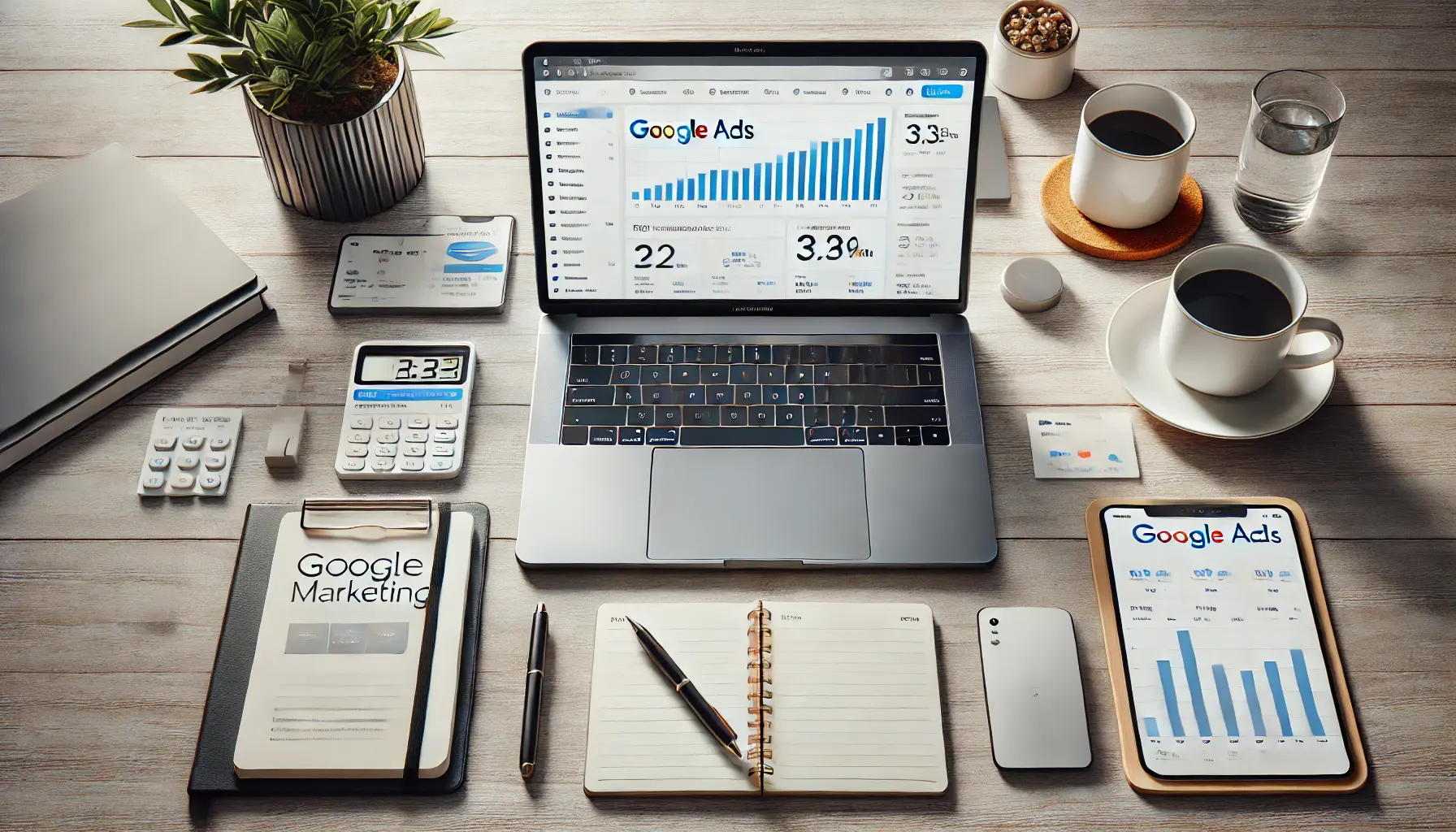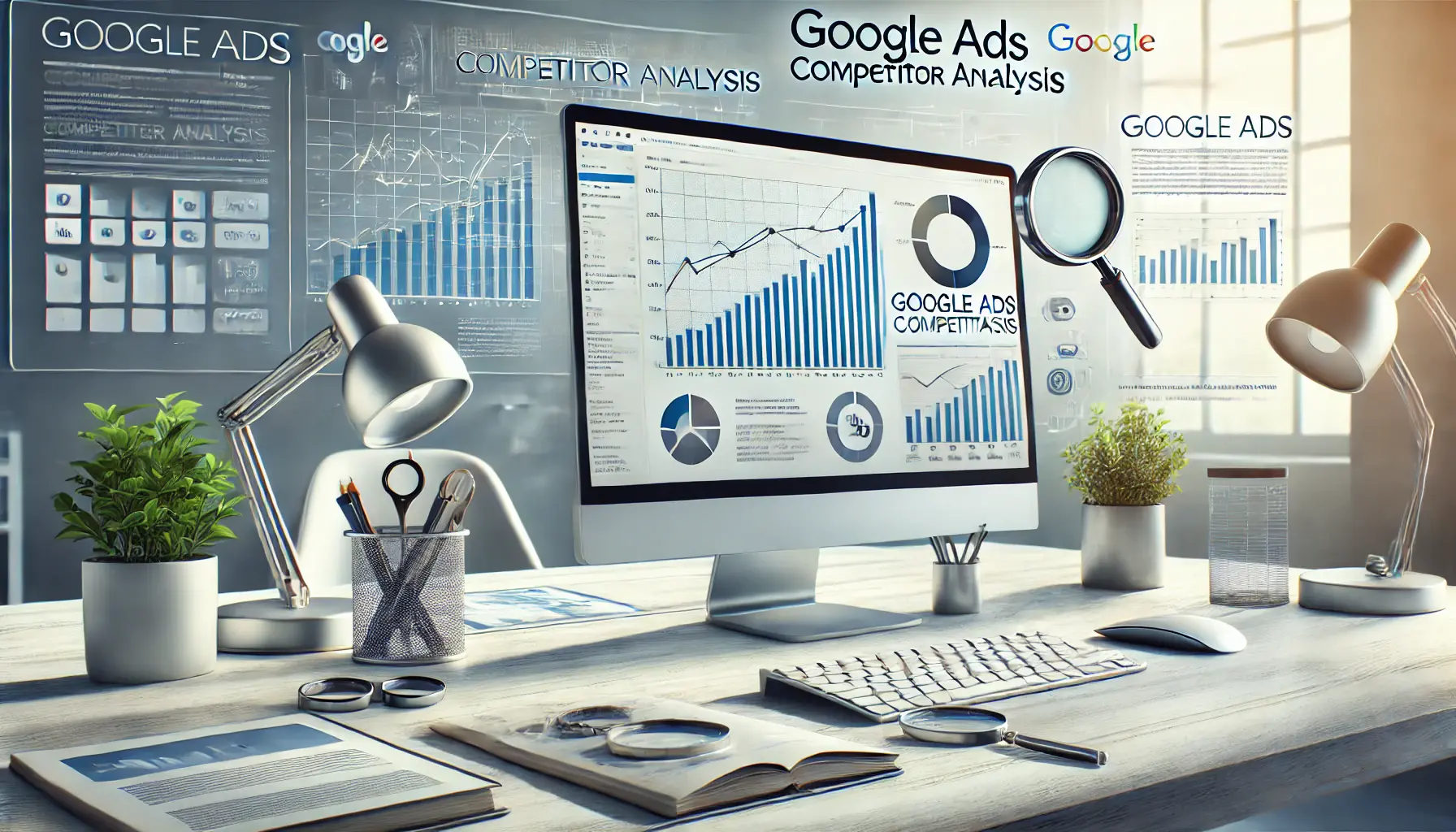With a dash of strategic planning, the successful running of Google Ads campaigns separates mediocrity from excellence.
Be it a small business or a digital marketing professional, knowing how to structure and execute your campaigns with precision will make all the difference.
Strategic planning is more than just setting up ads—it’s about defining your goals, targeting the right audience, and optimizing every element of your approach to achieve measurable success.
In this article, we’ll explore the critical components of strategic planning for Google Ads, starting with a deep dive into its core concepts and why it matters for your business.
- Understanding Strategic Planning for Google Ads
- Setting Goals and Objectives in Strategic Planning
- 3 Essential Elements of Google Ads Strategic Planning
- Optimizing Google Ads Through Data Analytics and A/B Testing
- Common Mistakes to Avoid in Google Ads Strategic Planning
- Strategic Planning: The Key to Google Ads Success
- Frequently Asked Questions on Strategic Planning in Google Ads
Understanding Strategic Planning for Google Ads
Strategic planning for Google Ads involves creating a comprehensive roadmap that guides your advertising efforts from start to finish.
It’s about answering crucial questions: What do you want to achieve?
Who are you targeting?
How will you measure success?
By addressing these questions upfront, you can ensure that your campaigns align with your business goals and maximize return on investmentThe ratio of net profit to the cost of an investment, expressed as a percentage..

Team collaboration for strategic advertising planning.
What is Strategic Planning in Advertising?
Strategic planning in advertising is the process of defining a clear path to reach your advertising objectives.
It includes analyzing your market, understanding your audience, and establishing measurable goals.
In Google Ads, this involves deciding on the ad types to run, selecting keywords, and determining how to allocate your budget effectively.
Without strategic planning, campaigns often lack focus and fail to deliver optimal results.
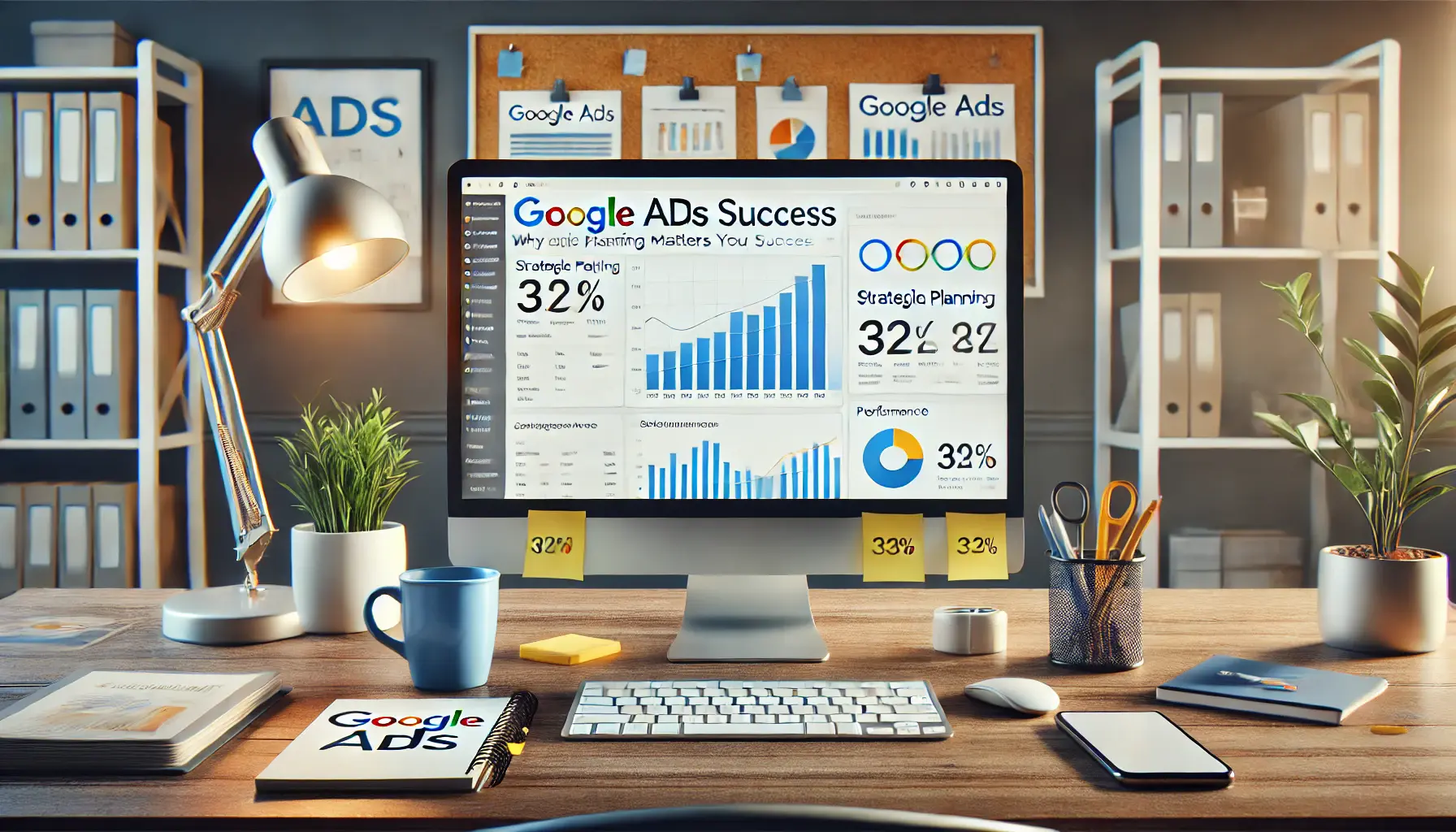
Digital marketing workspace emphasizing strategic planning for Google Ads.
Why Strategic Planning Matters for Google Ads Success
Google Ads is a competitive platform where every click counts.
Strategic planning ensures that your ads reach the right people at the right time with the right message.
By carefully planning your approach, you can avoid common pitfalls like wasted ad spend and low engagement.
Instead, you’ll be equipped to make data-driven decisions that boost your click-through rates and conversion rates.

Marketing professional analyzing the benefits of strategic planning in ad campaigns.
Key Benefits of Strategic Planning in Ad Campaigns
Strategic planning brings numerous benefits to your Google Ads campaigns, including:
- Better resource allocation: Use your budget effectively by focusing on high-performing keywords and demographics.
- Higher ROI: Achieve more with less by targeting audiences who are most likely to convert.
- Improved ad relevance: Deliver messages that resonate with your audience, leading to higher engagement.
- Data-driven decisions: Analyze performance metrics to refine your campaigns and improve results continuously.
By investing time in strategic planning, you set your Google Ads campaigns up for long-term success.
The next section will explore how to define clear goals and objectives to guide your advertising efforts.
Strategic planning answers key questions: What are your goals? Who is your audience? How will success be measured?
Addressing these ensures alignment with business objectives and maximized ROI.

Setting clear goals and objectives in strategic planning for success.
Setting Goals and Objectives in Strategic Planning
Establishing clear goals and objectives is a cornerstone of strategic planning for Google Ads.
It provides direction and a benchmark for measuring success.
Without well-defined goals, your advertising efforts may lack focus, leading to suboptimal results.
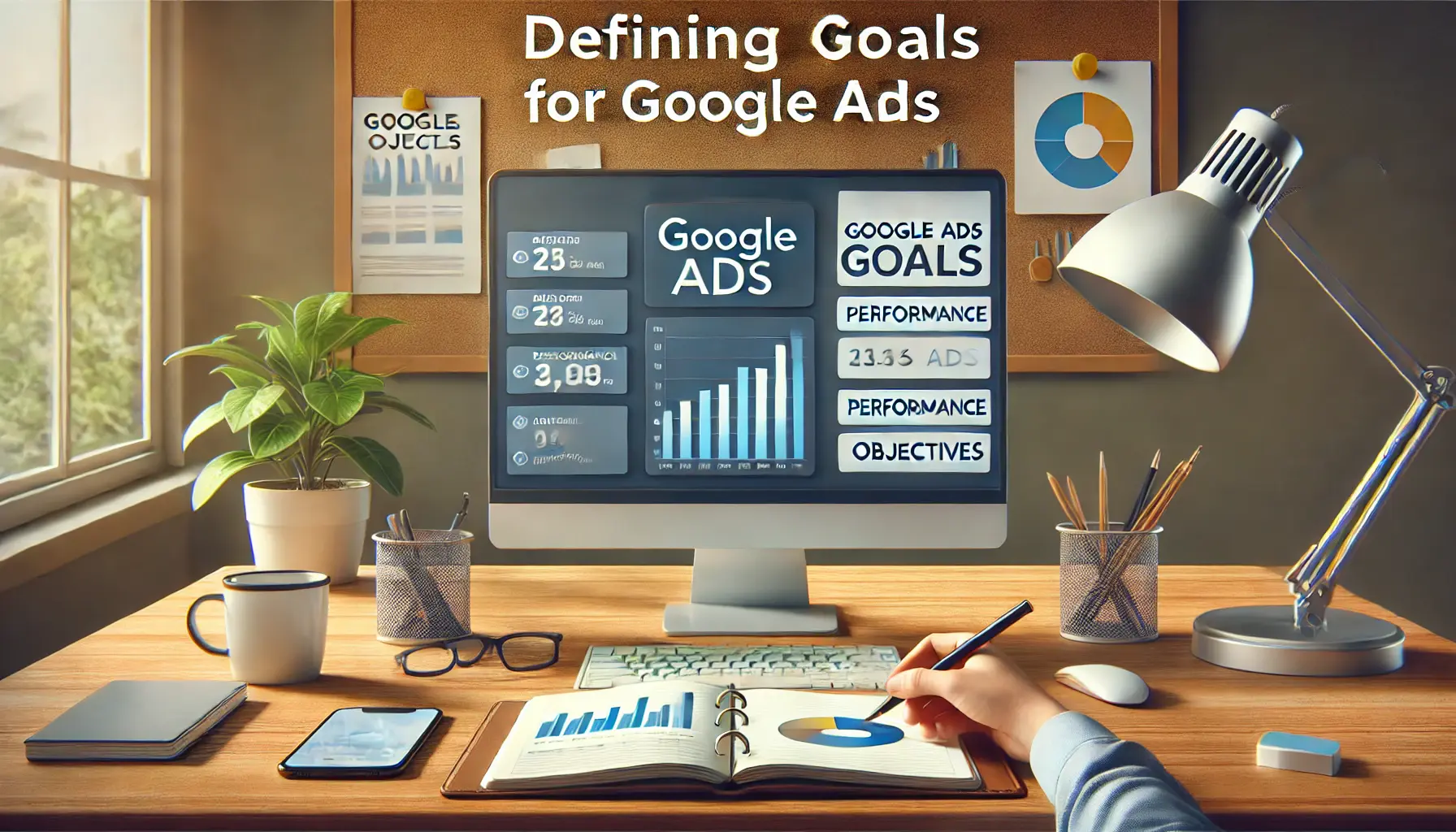
Defining clear goals for Google Ads campaigns.
How to Define Clear Goals for Google Ads
To define clear goals for your Google Ads campaigns, consider the following steps:
- Define Business Objectives: Determine what you would like to achieve through advertising, such as an increase in website traffic, lead generation, or sales.
- Set Specific Targets: Use the SMART criteria—Specific, Measurable, Achievable, Relevant, and Time-bound. For example, aim to increase website traffic by 20% within three months.
- Align with Marketing Strategies: Ensure your Google Ads goals complement your broader marketing strategies and contribute to overarching business objectives.

undefined
Measuring Success Through Strategic Objectives
Measuring the success of your Google Ads campaigns involves setting strategic objectives that serve as performance indicators.
These objectives could include:
- Conversion Rates: The percentage of ad clicks that result in desired actions, such as purchases or sign-ups.
- Cost Per Acquisition (CPA): The average cost incurred to acquire a customer through your ads.
- Return on Ad Spend (ROAS): The revenue generated for every dollar spent on advertising.
Regularly monitoring these metrics allows you to assess the effectiveness of your campaigns and make data-driven adjustments to enhance performance.

Aligning campaign goals with business objectives in a strategic planning session.
Aligning Campaign Goals with Business Objectives
It’s important to align your Google Ads campaign goals with your overall business objectives.
This alignment can be achieved through the following:
- Prioritization of Objectives: Focus on goals that directly contribute to the main aims of the business, such as brand awareness, lead generation, or sales growth.
- Coordinating Across Departments: Ensure collaboration between sales, marketing, and product teams to work toward common objectives.
- Using Consistent Messaging: Your ad content should reflect your brand’s values, resonate with your target audience, and reinforce your business goals.
By carefully setting and aligning your Google Ads goals with your business objectives, you will be well on your way to developing a sound advertising strategy.
The next section will cover the three key components of strategic planning for Google Ads.
Clear goals are the foundation of success. Use SMART criteria: Specific, Measurable, Achievable, Relevant, and Time-bound.
- Define objectives like increased traffic or lead generation.
- Set measurable targets, such as improving CTR by 10% in three months.
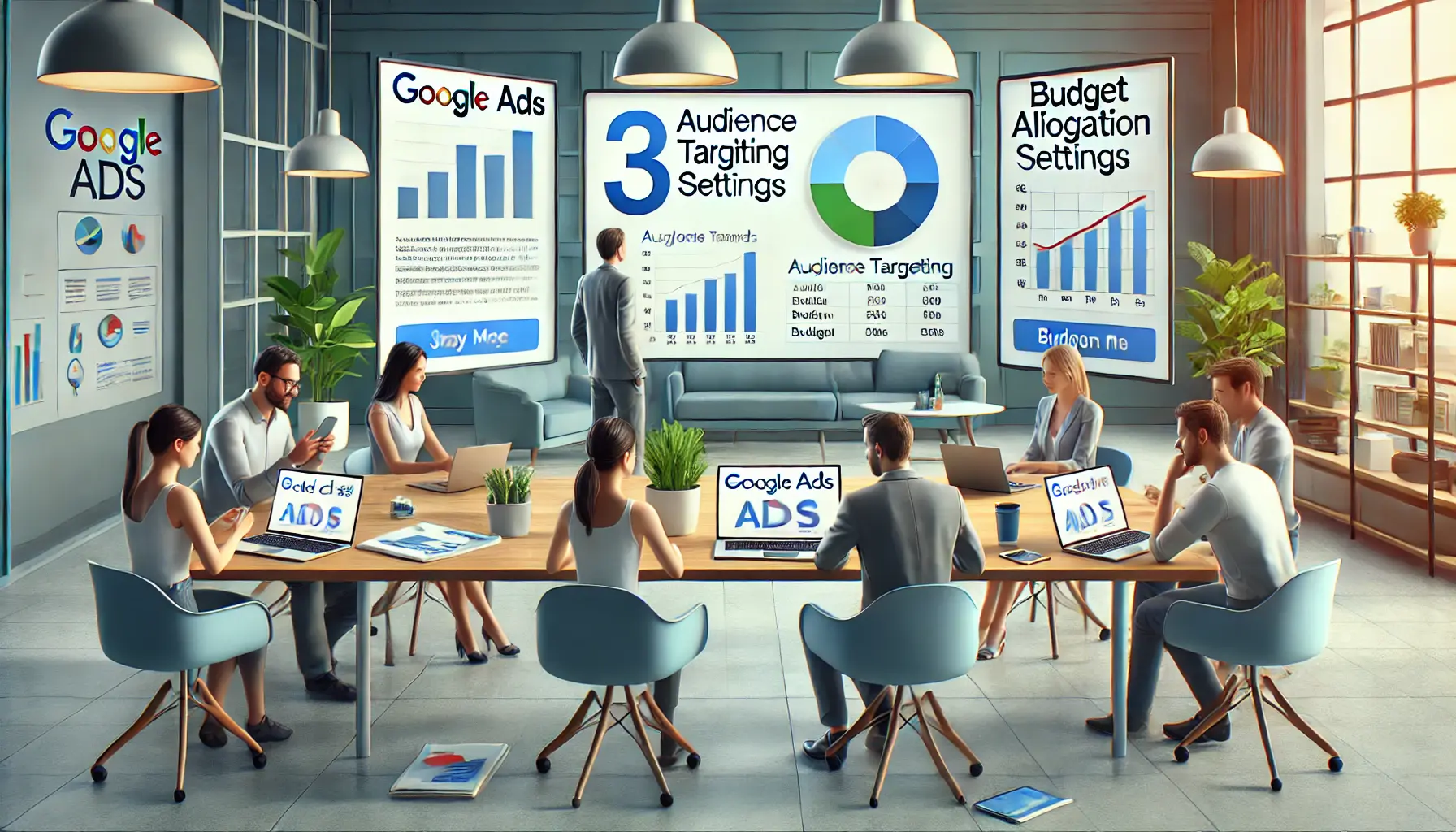
Collaborating on the 3 essential elements of Google Ads strategic planning.
3 Essential Elements of Google Ads Strategic Planning
Developing a successful Google Ads campaign hinges on three fundamental components: audience targeting and market research, budget allocation for maximum ROI, and creating impactful ad copy and design.
Mastering these elements ensures your ads reach the right audience, at the right time, with the right message.

Using market research and audience targeting for effective digital marketing.
Audience Targeting and Market Research
Understanding your target audience is crucial for effective Google Ads campaigns.
Conduct thorough market research to identify demographics, interests, and online behaviors of potential customers.
Utilize tools like Google Analytics to gain insights into audience segments and tailor your ads accordingly.
Precise audience targeting increases the relevance of your ads, leading to higher engagement and conversion rates.

Analyzing budget allocation for maximum ROI in digital marketing.
Budget Allocation for Maximum ROI
Setting a budget is key to the strategic distribution of money invested in Google Ads for ROI maximization.
Consider the following steps:
- Set Clear Objectives: Clearly define what you want to achieve with your ads, such as brand awareness, generating leads, or sales.
- Analyze Cost-Per-Click (CPC): Research the average CPC in your industry and estimate potential costs.
- Monitor and Adjust: Regularly review campaign performance and reallocate your budget to the ads that perform best.
By carefully managing your budget, you can ensure funds are directed towards strategies that yield the highest returns.

Designing impactful ad copy and visuals for effective marketing.
Creating Impactful Ad Copy and Design
Compelling ad copy and design are essential to capture attention and drive action.
Focus on the following elements:
- Clear Messaging: Ensure your ad copy clearly communicates the value proposition and includes a strong call-to-action.
- Visual Appeal: Use high-quality images or graphics that resonate with your target audience.
- Relevance: Ad content should align with the keywords and interests of your audience to enhance relevance and Quality Score.
By investing time in creating well-designed ads with persuasive copy, click-through and conversion rates can be significantly improved.
Additionally, integrating these three key components into your Google Ads strategic planning will help you create campaigns that successfully reach and convert your target audience, ultimately driving business growth.
Three pillars of effective Google Ads campaigns:
- Audience Targeting: Conduct thorough market research to understand demographics.
- Budget Allocation: Monitor performance and invest in high-performing strategies.
- Ad Copy and Design: Craft compelling messages with visual appeal.

Optimizing Google Ads through data analytics and A/B testing.
Optimizing Google Ads Through Data Analytics and A/B Testing
In the dynamic landscape of digital marketing, continuous optimization of your Google Ads campaigns is essential.
Leveraging data analytics and A/B testing enables you to make informed decisions, refine strategies, and enhance overall performance.

Leveraging data analytics for optimizing digital marketing campaigns.
Leveraging Data Analytics for Campaign Optimization
Data analytics serves as the backbone of effective Google Ads optimization.
By analyzing key performance indicators (KPIs) such as click-through rates (CTR), conversion rates, and cost per acquisition (CPA), you can identify trends and areas for improvement.
Utilizing tools like Google Analytics provides insights into user behavior, helping you understand which aspects of your campaigns resonate with your audience and which require adjustment.

Implementing A/B testing for continuous optimization of digital campaigns.
Implementing A/B Testing for Continuous Improvement
A/B testing, also referred to as split testingAnother term for A/B testing, where two versions of an element are compared to see which performs better., is a method that involves comparing two versions of either an ad or landing page against each other.
This approach enables you to test variables such as headlines, ad copy, images, and calls-to-action.
Testing creative ads and different elements on landing pages allows for a more personalized user experience, which helps drive up conversion rates.
Regular A/B testing supports data-driven decision-making, enabling businesses to adapt quickly to changing market dynamics and consumer preferences.

Staying informed on market trends and competitor strategies for competitive advantage.
Staying Informed on Market Trends and Competitor Strategies
It is important to stay on top of market trends and competitors’ strategies.
Conduct routine checks on developments within the industry and the activities of your competitors to identify opportunities and threats.
Tools like SpyFu can help uncover competitors’ keywords and ad strategies, enabling you to refine your own campaigns for better results.
By integrating data analytics, A/B testing, and market research into your strategic planning, you can optimize your Google Ads campaigns for improved performance and higher returns on investment.
The next section will discuss how to monitor and make changes to your campaigns to ensure sustained success.
Leverage data analytics to refine campaigns based on performance metrics.
- A/B Testing: Compare variations of ads to identify what works best.
- Market Trends: Monitor industry changes and competitor strategies to stay ahead.

undefined
Common Mistakes to Avoid in Google Ads Strategic Planning
Even with a well-crafted strategy, certain pitfalls can undermine the effectiveness of your Google Ads campaigns.
Being aware of these common mistakes and proactively avoiding them is crucial for maximizing your return on investment.

The impact of ignoring negative keywords in digital advertising.
Ignoring Negative Keywords
Failing to utilize negative keywordsKeywords that prevent ads from showing for certain search terms, reducing irrelevant clicks. can lead to your ads appearing for irrelevant searches, resulting in wasted ad spend.
Regularly review search term reports to identify and exclude terms that don’t align with your offerings.
This practice ensures your ads reach a more qualified audience.
The impact of overlooking conversion tracking in digital advertising.
Overlooking Conversion Tracking
Without proper conversion trackingA method to measure the actions users take after interacting with an ad, such as purchases or sign-ups., it’s challenging to assess the success of your campaigns.
Implementing conversion tracking allows you to monitor actions like purchases or sign-ups, providing insights into which strategies are effective and which need adjustment.

The impact of misusing broad match keywords in Google Ads.
Misusing Broad Match Keywords
Relying solely on broad matchA keyword match type in Google Ads that triggers ads for searches including misspellings, synonyms, and related searches. keywords can cause your ads to show for unrelated queries, leading to inefficient spending.
Employ more precise match types and regularly update your keyword list to maintain relevance.
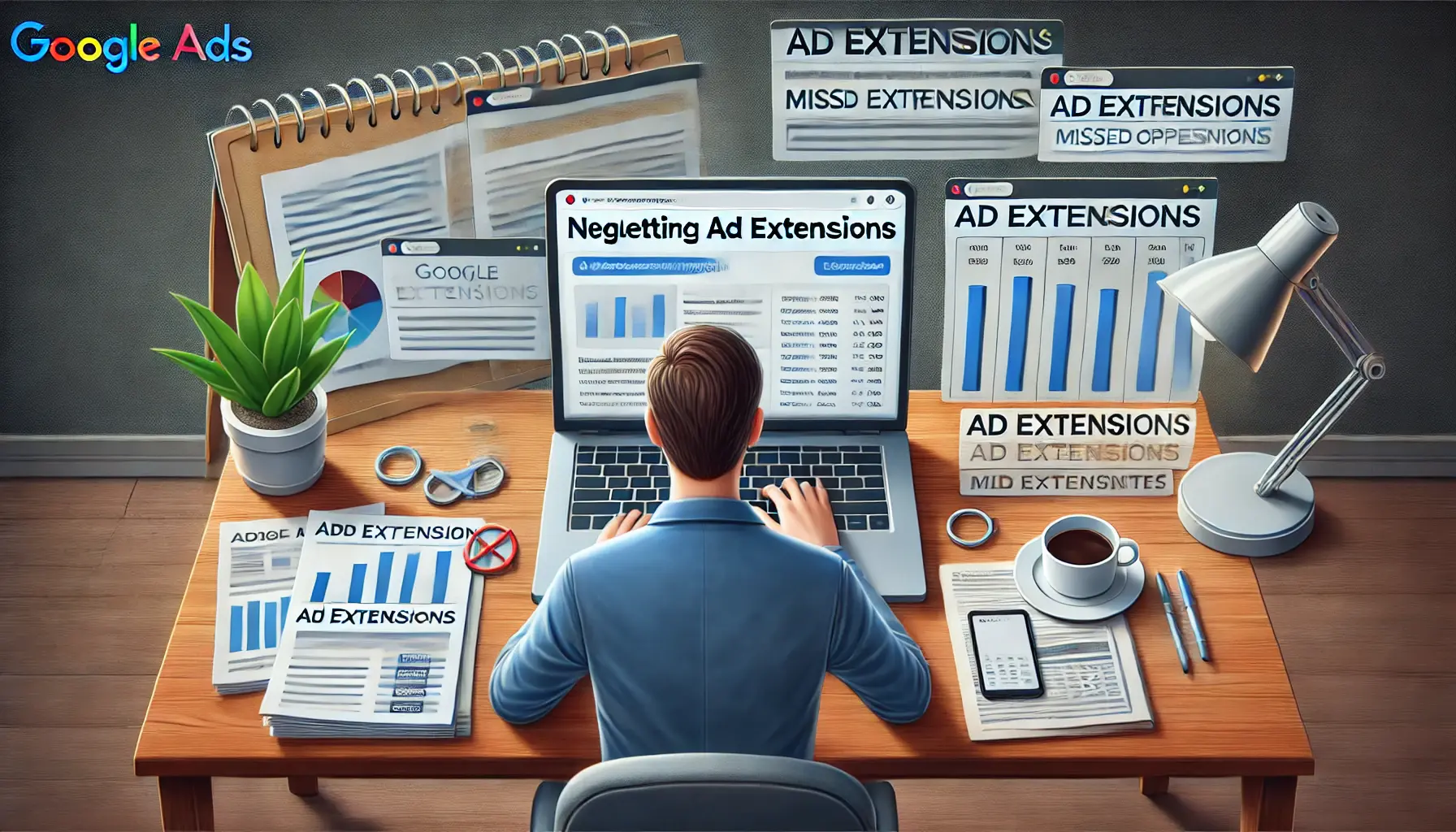
The impact of neglecting ad extensions in Google Ads campaigns.
Neglecting Ad Extensions
Ad extensions enhance your ads with additional information and can improve click-through rates.
Overlooking these features means missing opportunities to provide users with compelling reasons to engage with your ads.

undefined
Failing to Optimize for Mobile
With a significant portion of users accessing content via mobile devices, not optimizing your ads for mobile can result in a poor user experience and lost conversions.
Ensure your ads and landing pages are mobile-friendly to cater to this audience segment.
By being aware of these common mistakes and following best practices, you can make your Google Ads campaigns much more effective in achieving your strategic goals.
Avoid these common pitfalls:
- Ignoring negative keywords, leading to wasted ad spend.
- Overlooking conversion tracking, which prevents assessing campaign success.
- Failing to optimize ads for mobile users, resulting in missed conversions.
Strategic Planning: The Key to Google Ads Success
Strategic planning is the backbone of every successful Google Ads campaign.
By understanding and implementing the essential components outlined in this article, you can ensure your campaigns are well-optimized, targeted, and effective in achieving your business objectives.
Let’s recap the critical insights shared throughout this guide.

Key takeaways from strategic planning for successful campaigns.
Key Takeaways from Strategic Planning
Here are the pivotal aspects of strategic planning for Google Ads:
- Setting Precise Objectives: Set specific, quantifiable, and realistic goals for the ads, keeping in mind the broader business strategy of the client.
- Audience Targeting: Use in-depth market research to clearly identify the target demographics to which your ads should be tailored.
- Budgeting: Allocate funds judiciously in a manner that maximizes returns and keeps spending efficient.
- Ad Copy and Design: Construct attention-grabbing, engaging ads that deliver your message effectively to your target audience and inspire action.
- Data-Driven Optimization: Use analytics and A/B testing to refine your campaigns and adapt to market changes.
- Avoiding Common Pitfalls: Stay vigilant against mistakes such as ignoring negative keywords, overlooking conversion tracking, or neglecting mobile optimization.

The importance of continuous improvement in digital marketing strategies.
The Importance of Continuous Improvement
Google Ads is a dynamic platform where trends, audience behaviors, and market conditions are constantly evolving.
Strategic planning is not a one-time effort—it requires ongoing evaluation and optimization.
By staying informed about the latest practices and regularly updating your campaigns, you can maintain a competitive edge and achieve sustained success.

How strategic planning drives results in digital marketing campaigns.
How Strategic Planning Drives Results
Integrating strategic planning into your Google Ads campaigns ensures:
- More relevance and better engagement with your target audience.
- Economical resource utilization to yield a greater return on investment.
- Continuous growth and adaptation in the competitive digital landscape.
Strategic planning is more than a process; it’s a mindset that guides effective decision-making and empowers you to achieve your advertising goals.
By applying the insights and practices outlined in this article, you will be well-equipped to transform your Google Ads campaigns into a powerful tool for business growth and success.
Strategic planning is essential for achieving measurable success:
- Focus on objectives like ROI and audience targeting.
- Continuously optimize through analytics and testing.
- Avoid pitfalls to maximize efficiency and growth.
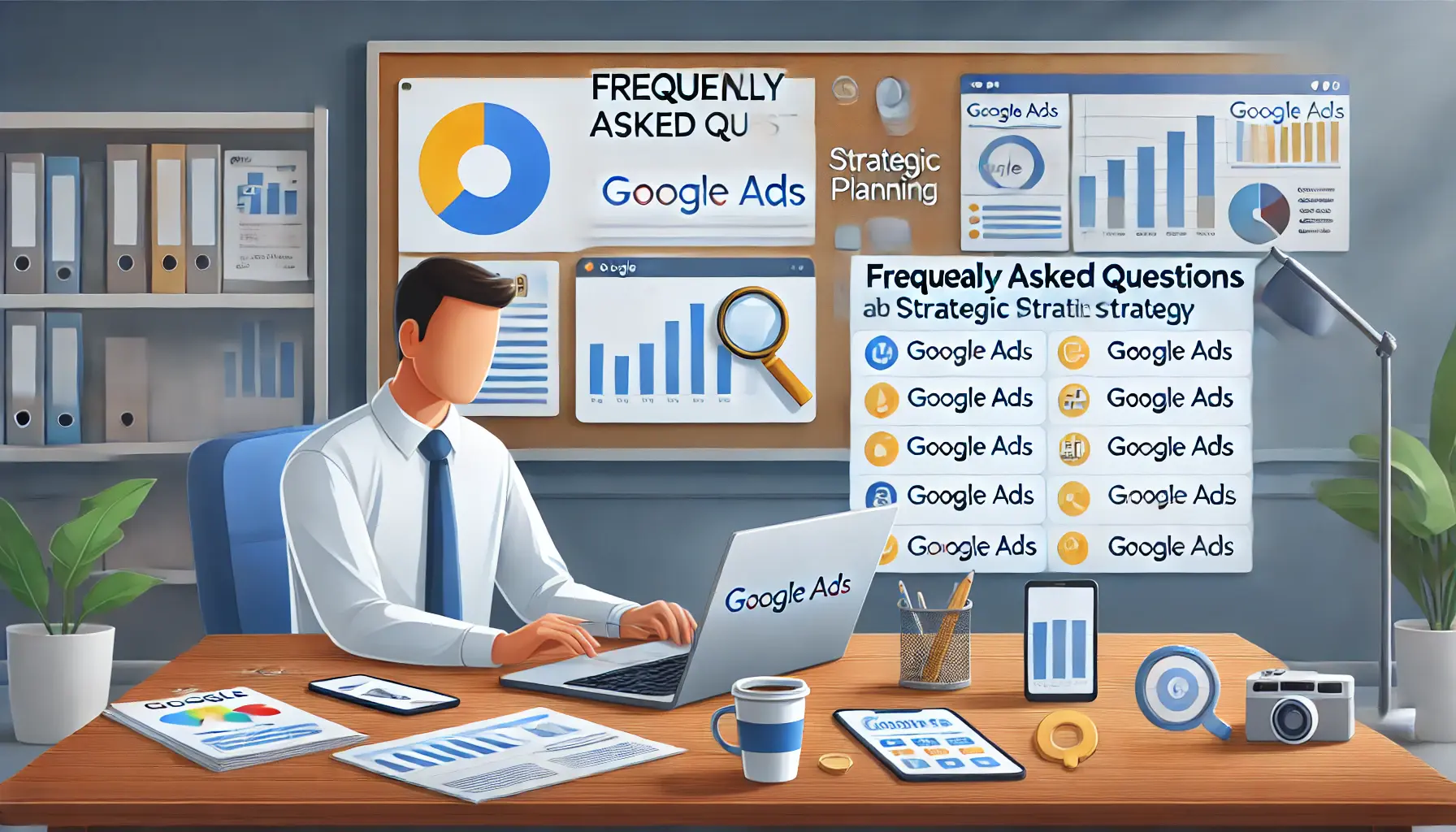
Addressing frequently asked questions about strategic planning in Google Ads.
Your campaigns can be managed by an agency specialized in Google Ads, check out our service page.
Frequently Asked Questions on Strategic Planning in Google Ads
Strategic planning is crucial for the success of Google Ads campaigns.
Below are some common questions and concise answers to guide you in optimizing your advertising efforts.
Strategic planning in Google Ads involves setting clear objectives, identifying target audiences, allocating budgets, and continuously optimizing campaigns to align with business goals and maximize return on investment.
Set SMART goals such as increasing website traffic by 20% within three months.
These goals should be Specific, Measurable, Achievable, Relevant, and Time-bound.
Audience targeting ensures your ads engage only with potential customers who are most interested.
This increases the efficiency and effectiveness of your campaigns.
Allocate your budget based on campaign goals, keyword competitiveness, and expected return on investment.
Regularly monitor and adjust spending to focus on high-performing areas.
Compelling ad copy and design capture attention and convey your message effectively, leading to higher click-through and conversion rates.
Data analytics provide insights into campaign performance, allowing you to make informed decisions, identify areas for improvement, and optimize strategies for better results.
A/B testing involves comparing two versions of an ad or landing page to determine which performs better, enabling continuous improvement and higher conversion rates.
Avoid pitfalls like ignoring negative keywords, overlooking conversion tracking, misusing broad match keywords, neglecting ad extensions, and failing to optimize for mobile devices.
The digital landscape is dynamic.
Ongoing evaluation and optimization of your campaigns ensure they remain effective and aligned with current market trends and audience behaviors.

